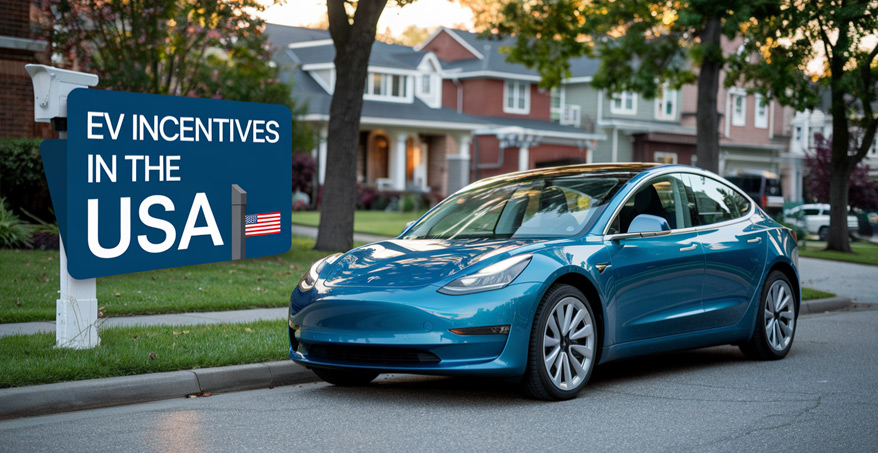Unlock major savings on electric vehicles in 2024 with our complete guide to USA EV incentives, covering federal tax credits, state rebates, and utility discounts for both individuals and businesses.
What You Need to Know to Maximize Your Savings
With electric vehicle (EV) adoption rapidly increasing, the USA has introduced various EV incentives at the federal, state, and local levels to support new and used EV buyers, as well as businesses looking to electrify fleets. Understanding these incentives can significantly reduce the cost of EV ownership and make the transition smoother for individuals and companies alike.
Here’s your guide to navigating EV tax credits, rebates, and utility incentives to maximize savings and make the most of going electric.
1. Federal EV Tax Credits for New and Used Vehicles
The federal government’s EV tax credit program is one of the largest incentives for buyers, providing substantial savings on eligible EV purchases. Here’s what you need to know:
- Federal Tax Credit for New EVs: Up to $7,500 is available for eligible new EVs, including some plug-in hybrids. Notably, the credit is available only for EVs assembled in North America.
- Income Limits: To qualify, single filers must earn below $150,000, and joint filers must earn below $300,000 in modified adjusted gross income.
- Vehicle Criteria: The vehicle must have a minimum battery capacity of 7 kWh, and the full credit amount depends on meeting specific manufacturing and battery sourcing requirements.
- Direct Transfer Option: Starting in 2024, car dealerships may apply the credit at the point of sale, making it easier for buyers to benefit immediately from the discount rather than waiting until tax season.
- Federal Tax Credit for Used EVs: Buyers of qualifying used EVs can receive up to $4,000 or 30% of the vehicle’s sale price, whichever is lower. This credit is available once per vehicle, which must be sold by a licensed dealer.
- Income Requirements: Similar to new EV credits, income eligibility caps apply, with single filers limited to $75,000 and joint filers to $150,000.
- Eligible Vehicles: The used EV must be at least two years old and cost less than $25,000 to qualify.
These credits are available across the U.S., but eligibility varies, so it’s important to check which EV models qualify before making a purchase.
2. State EV Incentives and Rebates
Many states offer additional EV incentives that can be combined with federal credits for even greater savings. Here are some popular programs:
- California: Known for its generous programs, California offers rebates through the Clean Vehicle Rebate Project (CVRP) of up to $2,000 for new EVs and $1,000 for plug-in hybrids. Low- and moderate-income residents may qualify for an additional rebate, and other local programs such as the California Clean Fuel Reward can provide up to $750 at the point of sale.
- Colorado: One of the highest state rebates, Colorado provides up to $5,000 for new EVs in 2024, making it a top choice for EV buyers in the Mountain States.
- New York: The Drive Clean Rebate offers up to $2,000 based on the car’s range and battery size. Additional rebates may be available for low-income residents through local New York utility companies.
- Texas: The Light-Duty Motor Vehicle Purchase or Lease Incentive Program provides up to $2,500 for EV buyers who meet eligibility requirements, while utility companies like Austin Energy offer rebates for home charging stations.
Each state has unique criteria, including income limits, residency requirements, and eligible vehicle lists. Check your state’s Department of Motor Vehicles (DMV) or energy office for a complete list of available rebates and tax incentives.
3. Local and Utility Company Incentives for EV Buyers
Local and utility-based EV incentives can make a big difference, especially for home charger installations and reduced charging costs:
- Home Charger Rebates: Many utility companies like Pacific Gas and Electric (PG&E) in California, Duke Energy in Florida, and Con Edison in New York offer rebates for installing Level 2 home chargers, typically covering up to $1,000 of the installation costs.
- Discounted Electricity Rates: Utilities often offer special rates for EV owners, with lower rates during off-peak hours. This makes it more affordable to charge your EV overnight, cutting down on fuel costs and encouraging efficient energy usage.
- HOV Lane Access: In states like California, EVs with qualifying stickers are permitted to use high-occupancy vehicle (HOV) lanes, which can significantly reduce commute times for solo drivers. Requirements vary, so check your state’s department of transportation for eligibility.
4. Incentives for Commercial EV Fleets
Businesses can also take advantage of commercial EV incentives for fleet electrification and infrastructure development. Here’s how:
- Federal Commercial EV Tax Credits: The Clean Commercial Vehicle Credit offers up to $40,000 for companies purchasing qualified commercial EVs, with the amount based on the vehicle’s weight and purpose.
- Charging Infrastructure Grants: Federal incentives like the Alternative Fuel Infrastructure Tax Credit cover 30% of the cost for installing EV chargers, up to $100,000. This credit is essential for businesses investing in infrastructure to support employee or customer charging needs.
- State-Specific Grants: Several states, including California, Oregon, and New Jersey, offer incentives and grants to help businesses electrify fleets and install EV chargers. Incentive amounts and qualifications vary by state, making it essential to check specific programs in your area.
These incentives help businesses reduce fuel and maintenance expenses, while also supporting environmental goals and aligning with future regulatory shifts favoring cleaner fleets.
5. EV Incentives for Used Vehicles
Buying a used EV can be even more affordable thanks to these incentives:
- Federal Tax Credit for Used EVs: The federal credit of up to $4,000 for used EVs applies to vehicles purchased through licensed dealerships. It’s intended to make EV ownership accessible for more Americans, and income limits apply, just like with new EV purchases.
- State Programs for Used EVs: Some states, such as California, provide additional incentives for low-income buyers of used EVs, expanding access to affordable and eco-friendly transportation. California’s Clean Cars for All Program offers rebates up to $5,000 for qualifying residents.
Driving Savings: Making the Most of EV Incentives
Navigating EV incentives can be complex, but the savings opportunities are well worth it. By combining federal tax credits, state rebates, utility discounts, and commercial EV programs, you can reduce the upfront cost of an EV and benefit from ongoing savings. From the eco-conscious family looking to buy a used EV to companies electrifying their fleets, these incentives make it easier to join the electric vehicle revolution.
Ready to explore your options? Dive into these 2024 EV incentives and find the best way to make your EV journey more affordable.


